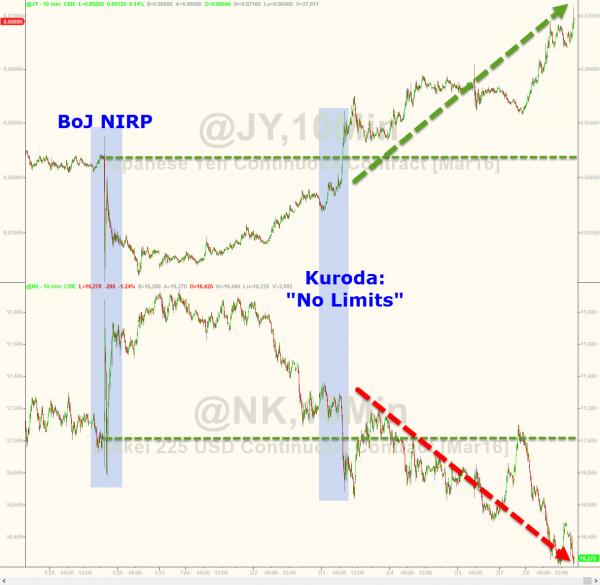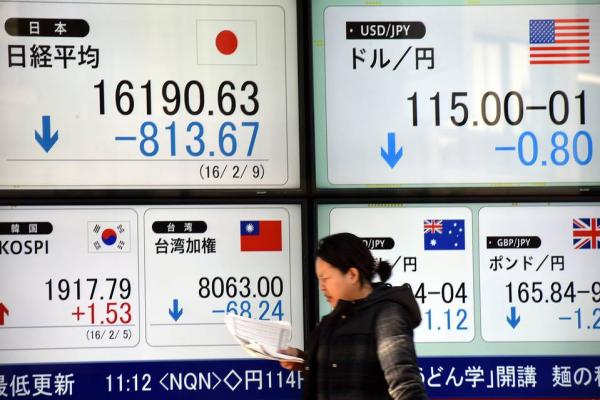With China offline for the rest of the week, global markets have found a new Asian bogeyman in the face of Japan which as reported last night saw its markets crash, and the Yen soar, showing that less than 2 weeks after the BOJ unveiled NIRP, yet another central bank has lost control.

The Nikkei crashed 5.4%, the biggest drop since June 2013, plunging over 900 points to August 24 lows driven by collapsing bank stocks while the Yen soared to 114.50 overnight before the BoJ desperately tried to push the Yen lower, with London dealers reported the Japanese central bank was checking rates and levels to prompt short covering through 115.

But while the BOJ failed to push up equities, it certain managed to launch a panic buying spree in JGBs, which as also reported finally saw the 10 Year Japanese TSY slide into negative yield territory, thus boosting the global number of bonds with a negative yield to just shy 30% of total or roughly $7 trillion!
Aside from Japan, everyone is looking at the bank which we first asked if it was “the next Lehman” last June, namely Germany’s Deutsche Bank, to see if yesterday’s desperate scramble to publicly confirm it has sufficient liquidity will sufficient will stop the price from dropping and its CDS drom blowing out. For now, the stock is indeed up modestly, even if the CDS has refused to tighten suggesting that whatever management did, it is not enough and it is only a matter of time before the selling returns.
As a result of this temporary stabilization in financials, the Europe 600 Index was little changed after closing Monday at its lowest level since 2014, and U.S. equity-index futures were also steady. European indexes of credit-default swaps on corporate debt fell for the first time in more than a week, Germany’s 10-year bund yield climbed the most this year and crude in New York rose above $30 a barrel. Equities in Tokyo slumped earlier by the most since August and the yield on 10-year Japanese government bonds turned negative for the first time.
“Volatility is getting very high,” Guillermo Hernandez Sampere, head of trading at MPPM EK in Eppstein, Germany told BLoomberg. “Investors need to increase their cash and be careful in case they see any buying opportunities. A technical rally may easily get sold again, we won’t come back to calm waters soon.”
While oil took on secondary importance during yesterday’s financial-led rout, expect algos and even human traders to pay more attention to crude today after the latest IEA monthly reported predicted supply will exceed demand by an avg of 1.75m b/d in 1H, compared w/ fcast of 1.5m last month. “With the market already awash in oil, it is very hard to see how oil prices can rise significantly in the short term. In these conditions the short term risk to the downside has increased,” IEA says. It added that the global oil demand fcast for 2016 100k b/d lower than previous mos. report at 95.6m b/d. Elsewhere, Goldman once again warned that oil may drop into the teens as land storage capacity is exhausted.
Looking at today’s calendar, it’s another fairly quiet session for data in Europe this morning with the only releases of note being the December trade numbers out of the UK and Germany along with the latest industrial production data in the latter. Over in the US the early release is the NFIB small business optimism survey for January, followed by the December JOLTS job openings and wholesale trade sales and inventories data. As a reminder, JOLTS data is released with a one-month lag so the data will be reflecting what was a bumper month for hiring (payrolls +262k) in December and not reflective of the recent softer payrolls number. Earnings wise we’ve got 18 S&P 500 companies set to report including Walt Disney and Coca-Cola.
Market Wrap
Top Global News













Leave A Comment